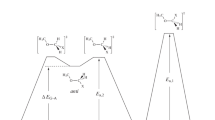Abstract
The nature of methyl internal rotational barrier in thioacetaldehyde has been investigated by relaxation effect, natural bond orbital (NBO) analysis and Pauling exchange interactions. The true experimental barrier can be obtained by considering fully relaxed rotation. Nuclear-electron attraction term is a barrier forming term in the fully relaxed rotation, but it appears as an antibarrier for rigid rotation. It is seen that during methyl rotation, the torsional mode is coupled with the aldehydic hydrogen out-of-plane wagging motion. Natural bond orbital analysis shows that the principal barrier forming term originates from the C-C bond. The lengthening of the C-C bond is explained by considering charge transfer interaction between several bonding and antibonding orbitals in the C-C bond region, which leads to higher bonding overlap for the eclipsed conformer compared to the staggered conformer. S-C(σ)/Cme-Hp and C-Hald/Cme-Hop interactions appear to be the main barrier-forming Pauling exchange terms but have less contribution to make to the barrier compared to the C-C bond interaction.
Similar content being viewed by others
References
Groner P, Sullivan J F and Durig J R 1981Vibrational spectra and structure (Amsterdam: Elsevier) vol 9, pp 405–496
Goodman L and Pophristic V 1998The encyclopedia of computational chemistry (John Wiley & Sons: Chichester) vol. 4, pp 2525–2541; Goodman L, Pophristic V and Weinhold FAcc. Chem. Res. (accepted)
Lister D G, MacDonald J N and Owen N L 1978Internal rotation and inversion: An introduction to large amplitude motions in molecules (New York: Academic Press)
Veillard A 1974 InInternal rotation in molecules (New York: John Wiley and Sons) pp 385–421
Goodman L and Gu H 1998J. Chem. Phys. 109 72
Goodman L, Gu H and Pophristic V 1999J. Chem. Phys. 110 4268
Goodman L and Pophristic V 1996Chem. Phys. Lett. 259 287
Pophristic V, Goodman L and Guchhait N 1996J. Phys. Chem. 101 92
Thakur S N, Guo D, Kundu T and Goodman L 1992Chem. Phys. Lett. 199 335;PhilisJGand Goodman L 1993J. Chem. Phys. 98 3795
Kleiner I, Hougen J T, Suenram R D, Lovas F J and Godefroid M 1991J. Mol. Spectrosc. 148 38
Belov S P, Tretyakov M Yu, Kleiner I and Hougen T J 1993J. Mol. Spectrosc. 160 61
Leszcynski J and Goodman L 1993J. Chem. Phys. 99 4867; Goodman L, Leszczynski J and Kundu T 1994J. Chem. Phys. 100 1274
Hehre W J, Pople J A and Devaquet A J P 1976J. Am. Chem. Phys. 98 664
Sovers O J, Kern C W, Pitzer R M and Karplus M 1968J. Chem. Phys. 49 2592; PitzerRM 1983Acc. Chem. Res. 16 207; Jorgensen W L and Allen L C 1971J. Am. Chem. Soc. 93 567; Munoz-caro C, Nino A and Moule D C 1994Theor. Chim. Acta. 88 299; Hadad C M, Foresman J B and Wiberg K B 1993J. Phys. Chem. 94 4293
Goodman L, Kundu T and Leszczynski J 1995J. Am. Chem. Soc. 117 2082
Guo D and Goodman L 1996J. Phys. Chem. 100 12540
Kroto H W and Landsberg B M 1976J. Mol. Spectrosc. 62 346
Judge R H, Moule D C, Bruno A E and Steer R P 1983Chem. Phys. Lett. 102 385
Paone S, Moule D C, Bruno A E and Steer R P 1984J. Mol. Spectrosc. 107 1
Moule D C, Smeyers Y G, Senenet M L, Clouthier D J, Karolczak J and Judge R H 1991J. Chem. Phys. 95 3137
Judge R H, Moule D C, Bruno A E and Steer R P 1987J. Chem. Phys. 87 60; Smeyers Y G, Nino A and Bellido M N 1988Theor. Chim. Acta 74 259
Smeyers Y G, Nino A and Moule D C 1990J. Chem. Phys. 93 5786
Ab-initio calculation program, Gaussian 94, Frisch M Jet al Gaussian Inc., Pittsburgh PA, 1995
Reed A E and Weihold F 1983J. Chem. Phys. 78 4066
NBO 4.0. Glendening E D, Badenhoop J K, Reed A E, Carpenter J E and Weinhold F 1996 Theoretical Chemistry Institute, University of Wisconsin, Madison
Foster J P and Weinhold F 1980J. Am. Chem. Soc. 102 7211
Badenhoop J K and Weihold F 1997J. Chem. Phys. 107 5406; Badenhoop J K and Weihold F 1997J. Chem. Phys. 107 5422
Guchhait N (unpublished results)
Reed A E and Weinhold F 1983J. Chem. Phys. 78 4066
Reed A E, Curtiss L A and Weinhold F 1988Chem. Rev. 88 899
Reed A E and Weinhold F 1991Isr. J. Chem. 31 277
Author information
Authors and Affiliations
Rights and permissions
About this article
Cite this article
Guchhait, N. Partitioning of methyl internal rotational barrier energy of thioacetaldehyde. J Chem Sci 114, 61–74 (2002). https://doi.org/10.1007/BF02709982
Received:
Revised:
Issue Date:
DOI: https://doi.org/10.1007/BF02709982



